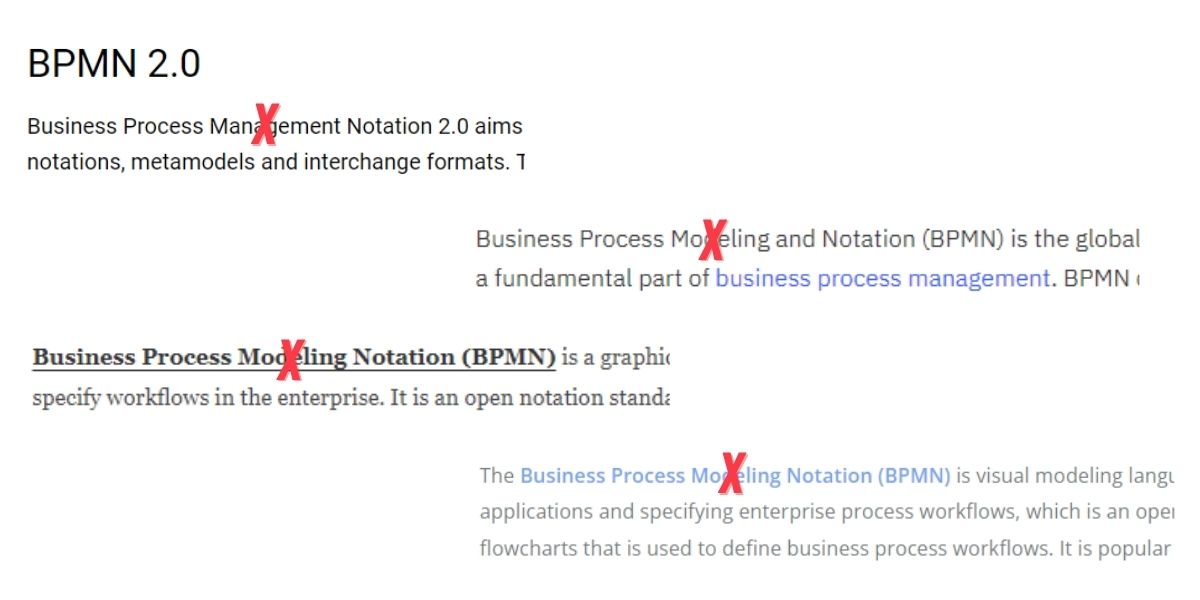What is BPMN 2.0 and why should I care about it?

06-03-2024
6 min
What is BPMN 2.0?
If you want to answer this question, you can find many wrong answers on the Internet. Here are a few examples:

Let's make it clear once and for all.
BPMN stands for Business Process Model and Notation. We can write this acronym in yet another way to understand it: Model of a Business Process and Notation of a Business Process.
BPMN 2.0 is the industry standard for business process modeling. Version 2.0 is the latest and most widely adopted version of the standard.
BPMN is maintained by the Object Management Group (OMG), a Standards Development Organization.
You could say that BPMN is a kind of pictorial writing, similar to Egyptian hieroglyphs.

BPMN focuses on a process-oriented approach to modeling systems. Let's break down each part of the BPMN acronym in the following paragraphs.
Business Process
A process is a set of activities that uses inputs to deliver an intended result. A Business Process is performed in order to achieve a specific business outcome, e.g., to deliver an order, publish a blog post or hire an employee.
Business processes exist at all organizational levels.
Process Model
A Process model is a definition or representation of a business process. It is a complete map covering every possible scenario. It describes all possible cases, from any possible starting point to any possible end point.
As an example let's imagine a simplified meal ordering process. We have defined two disjoint cases - nonvegetarian and vegetarian.
 By representing all cases, we create a model of the process.
By representing all cases, we create a model of the process.
and Notation
The easiest way to define process models is to use graphical notation (circles, rectangles, diamonds, and so on). BPMN 2.0 uses a specific set of symbols, to represent complex processes.
In general, drawing a process involves specifying elements (nodes) and connecting them with arrows.
Why should I care about BPMN 2.0?
Processes are everywhere!
If you want to buy something online, you follow a defined process. In an organization you can find many examples of business processes, from recruitment to employee onboarding, to various marketing processes, accounting and finance processes, project management processes and many more.
You might describe processes using a natural language, but you won't avoid ambiguity.
You can use your own graphical notation, but because it does not follow a worldwide standard, not everyone will understand it as you intended.
BPMN is a standardised and easy to understand way of representing your processes.
Benefits
BPMN allows you to get rid of ambiguity by creating standardized and easy-to-read diagrams.
It is a common language shared by business and IT users.
It can be used for a wide range of applications, from creating documentation to process analysis and improvement.
Where can I learn more about BPMN 2.0?
The most important resource is the official BPMN standard website https://www.omg.org/spec/BPMN where you can download the BPMN 2.0 Specification. This is your source of truth about BPMN.
It would be hard to learn BPMN by reading the specification alone, because it is not a document created to learn BPMN. Take the quiz below to test your knowledge!
✔❌ BPMN 2.0 Quiz (Level 1, Lesson 1) 📝
Take the BPMN 2.0 Lesson 1 Quiz
What else should I know?
Want to see more about models and modeling? Watch this short video: What's a Model? Why should I model?
Do you want to check your BPM/BPMN knowledge and achieve OMG certifications? Check the BPM 2 Certification program and BPM 2 Practise Exam Questions and Courses.
Source of the picture of Egyptian hieroglyphs: https://thebelladonnacomedy.com/woefully-misinterpreted-hieroglyphics-translated-by-the-women-of-ancient-egypt-fde82d44691

